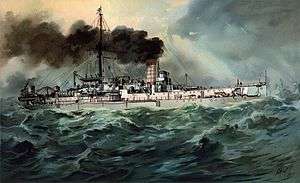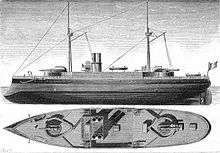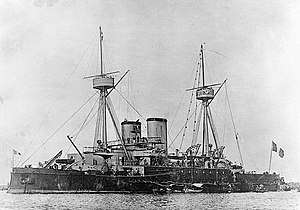Terrible-class ironclad
The Terrible class was a group of four ironclad barbette ships built for the French Navy in the late 1870s and early 1880s. The class consisted of Terrible, Indomptable, Caïman, and Requin. They were built as part of a fleet plan started in 1872 after the Franco-Prussian War and were designed in response to the German Sachsen class of barbette ships. The Terribles were scaled down versions of the Amiral Baudin class, with one less main gun, though they were of significantly larger caliber. Because the ships were intended for operations against the German fleet in the shallow Baltic Sea, they had a low draft and freeboard, which greatly hampered their seakeeping and thus reduced their ability to be usefully employed after entering service. Armament consisted of a pair of 420 mm (16.5 in) guns in individual barbettes, which were the largest guns ever mounted on a French capital ship.
.jpg) Requin in Britain in 1892 | |
| Class overview | |
|---|---|
| Operators: |
|
| Preceded by: | Vauban class |
| Succeeded by: | Amiral Baudin class |
| Built: | 1877–1888 |
| Completed: | 4 |
| Scrapped: | 4 |
| General characteristics | |
| Displacement: | 7,530 long tons (7,650 t) |
| Length: | 82.75 m (271 ft 6 in) pp |
| Beam: | 17.98 m (59 ft) |
| Draft: | 7.98 m (26 ft 2 in) |
| Installed power: |
|
| Propulsion: |
|
| Speed: | 14.5 to 15 kn (26.9 to 27.8 km/h; 16.7 to 17.3 mph) |
| Complement: | 373 |
| Armament: |
|
| Armor: |
|
Because of their poor seakeeping, the ships had limited careers, seeing active service for only a few years in the late 1880s and early 1890s. Thereafter, they spent much of their time in reserve, being activated only for fleet maneuvers. Requin made one voyage abroad to visit Russia and Great Britain in 1891. The ships were modernized in the late 1890s, receiving new guns, and in the case of Requin, new engines and boilers and some upgrades to her armor. Terrible was broken up in 1911, and only Requin was still in service by the start of World War I in 1914. She was stationed as a guard ship in the Suez Canal, and she helped to repel an Ottoman attack in February 1915. She was scrapped in 1920 and the other two vessels were discarded in 1927.
Design

The Terrible class of ironclad barbette ships was designed in the late 1870s as part of a naval construction program that had begun under the post-Franco-Prussian War fleet plan of 1872. Initially, the French built two types of armored capital ships, the first a series of high-freeboard barbette ships, and the second being smaller coast defense ships descended from the monitors that had been built in the 1860s. By 1877, the Italian fleet under Benedetto Brin had begun building powerful new ironclads of the Caio Duilio and Italia classes, which demanded a French response. Under the direction of Admiral Louis Pierre Alexis Pothuau beginning with the high-freeboard Amiral Duperré of 1877, followed by the Amiral Baudin-class ironclads. In addition, the oldest generation of French ironclads, wooden-hulled vessels built in the early-to-mid 1860s, were in poor condition and necessitated replacement. Gun size during this period increased dramatically, driven principally by the desire to keep up with Italy, which had begun to use massive 450 mm (17.7 in) guns it its latest ironclads.[1]
French capital ship design practices were interrupted by the development of the German Sachsen-class ironclads; these were coastal defense vessels that were significantly more powerful than the French coastal defense ships that had already been built under the 1872 plans. Amiral Duperré and the Amiral Baudins, powerful enough to defeat the Sachsens but significantly larger than previous generations of French ironclads, had too deep a draft to allow them to comfortably operate in the Baltic Sea. As a result, the French designers scaled down the Amiral Baudin design, removing its central barbette and reducing their freeboard to lighten them and thus reduce their draft. But instead of retaining the 370 mm (14.6 in) guns of the Amiral Baudin class, a larger 420 mm (16.5 in) gun was chosen for the new ships.[2] Curiously, though the Terrible design was derived from that of the Amiral Baudin class, work on the former began more than two years before the Amiral Baudins were laid down.[3] The class suffered from significant design faults, most significantly the arrangement of the guns; because they were placed on the centerline, they were arranged for fighting on the broadside. But their short belt, which was almost completely submerged under service conditions, did not sufficiently protect them from damage.[4]
Characteristics

The ships of the Terrible class were 82.75 m (271 ft 6 in) long between perpendiculars, with a beam of 17.98 m (59 ft) and a draft of 7.98 m (26 ft 2 in). They displaced 7,530 long tons (7,650 t) and had a relatively low freeboard. Their hulls were divided into eleven or twelve watertight compartments by transverse bulkheads. They were fitted with a pair of pole masts equipped with spotting tops for their main battery guns. The crew consisted of 373 officers and enlisted men.[3] The ships suffered from very poor seakeeping owing to their shallow draft, severely handicapping their usefulness in service.[5]
Their propulsion machinery consisted of two compound steam engines, each driving a single screw propeller, with steam provided by twelve coal-burning fire-tube boilers in the first three ships. Requin only received ten of the boilers. The ships' boilers were ducted into four small funnels placed in two pairs, side by side, directly astern of the conning tower. All four ships' engines were rated to produce 6,500 indicated horsepower (4,800 kW) for a top speed of 14.5 to 15 knots (26.9 to 27.8 km/h; 16.7 to 17.3 mph).[3]
Their main armament consisted of two 420 mm (16.5 in) guns, one forward and one aft, mounted on the centerline in barbettes. These were 22-caliber guns, though Terrible's guns had to be shortened to 19.3 calibers after initial testing revealed cracks at the muzzle.[3] They were the largest guns ever carried by a French capital ship.[6] These guns were supported by a secondary battery of four 100 mm (3.9 in) guns carried in individual pivot mounts with gun shields. For defense against torpedo boats, they carried two or four 47 mm (1.9 in) 3-pounder Hotchkiss revolver cannon and sixteen 37 mm (1.5 in) 1-pounder Hotchkiss revolvers, all in individual mounts. Their armament was rounded out with four 356 mm (14 in) torpedo tubes.[3]
Terrible was protected with mild steel armor, while the other ships received newer compound armor. Their belt extended for the entire length of the hull and was 508 mm (20 in) thick in the central portion, where it protected the propulsion machinery and the ammunition magazines, tapering to 410 mm (16 in) on the bottom edge. The bow section was reduced to 305 mm (12 in) at the waterline and 254 mm (10 in) on the bottom edge, while the stern section was 305 mm at the waterline and 203 mm (8 in) at the bottom edge. At even normal loading, the belt was nearly submerged entirely, reducing its effectiveness significantly. The barbettes for the main battery were 457 mm (18 in) thick and the supporting tubes that connected them to the ammunition magazines were 203 mm; these extended down to where they met the armor deck, which was connected to the top of the belt. The deck consisted of 81 mm (3.2 in) of either iron or mild steel over another layer of 25 mm (0.98 in) of steel. The sides of their conning towers were also 25 mm, as were the shields for the 100 mm guns.[3]
Modifications

All four ships were modernized around 1898, having their old 420 mm guns replaced with new weapons. Terrible received a pair of 340 mm (13.4 in) Modèle 1893 guns; these were 35-caliber guns, while the other four vessels exchanged their old main guns for two 274 mm (10.8 in) Modèle 1893/1896 40-caliber guns. Their secondary battery was replaced with quick-firing versions of 100 mm guns, with an additional pair being installed. The light battery was also revised to fourteen 47 mm guns. The first three ships had two of their torpedo tubes removed, while Requin lost all four of hers. Requin also had her propulsion system replaced with a pair of triple-expansion steam engines and twelve Niclausse boilers, which were the water-tube type. She also received 254 mm of new, stronger Harvey armor in place of the heavy compound armor for her main battery barbettes. As a result of these changes, the standard crew for all four ships was reduced to 332 officers and men.[3][7]
Ships
| Name | Builder[3] | Laid down[3] | Launched[3] | Completed[3] |
|---|---|---|---|---|
| Terrible | Brest | December 1877 | 1881 | January 1887 |
| Indomptable | Lorient | June 1878 | 19 September 1883[8] | February 1887 |
| Caïman | Toulon | December 1878 | May 1885 | 1888 |
| Requin | Forges et Chantiers de la Gironde | December 1878 | June 1885 | December 1888 |
Service history

The insufficient freeboard of the Terrible class significantly reduced their seaworthiness and frequently caused problems for the ships while at sea.[5] Indomptable had repeated problems in the late 1880s during fleet operations in the Mediterranean Sea,[9][10] and Requin experienced problems with flooding while steaming in the English Channel since her low forecastle proved incapable of keeping water out.[11] Owing to their poor seakeeping, they proved to be difficult to employ for the French fleet, since they could only be used in sheltered coastal waters. As a result, their careers were limited, though they did see brief periods of active service in the Mediterranean Fleet and the Northern Squadron, the latter confined to the English Channel.[5] By the early 1890s, Terrible, Indomptable, and Caïman had been reduced to the Reserve Squadron of the Mediterranean Fleet, remaining in service only for the annual fleet maneuvers; the rest of the year they were kept in reserve with reduced crews.[12] Requin spent her early career in the Northern Squadron, and during this period, made one voyage abroad to visit Russia and Great Britain in 1891.[13]
All four members of the class were refitted in 1890s, the primary alterations being a new battery of main and secondary guns, though Requin received a more extensive reconstruction that included a new propulsion system and some armor improvements.[3] Terrible was the only member of the class to be reactivated by 1900,[14] and Indomptable was employed as a guard ship in Toulon in 1902. Terrible was laid up that year,[15] and by 1903, all members of the class were out of service, as a series of pre-dreadnought battleships had been built, taking their places in the squadrons of the fleet.[16] Indomptable, Caïman, and Requin returned to active service in 1906 for that year's fleet maneuvers.[17] Terrible was stricken from the naval register in 1911 and broken up.[3] Requin was the only member of the class to see action during World War I, being stationed in the Suez Canal to defend it against attacks from the Ottoman Empire; she helped repulse an attack in February 1915 and dueled with Ottoman field artillery.[18] She was ultimately sold for scrap in 1920, while the other two ships lingered on in the French Navy's inventory until 1927, when they too were broken up.[3]
Notes
- Ropp, pp. 92–97.
- Ropp, pp. 97–98.
- Gardiner, p. 291.
- Ropp, pp. 100–101.
- Ropp, p. 180.
- Ropp, p. 99.
- Brassey & Leyland, p. 24.
- French Iron Clads, p. 7051.
- Reed & Simpson, pp. 94, 103.
- Brassey 1890, p. 182.
- Brassey 1893, p. 69.
- Weyl, p. 95.
- Feron, pp. 71–72.
- Jordan & Caresse, p. 218.
- Brassey 1902, p. 48.
- Jordan & Caresse, p. 223.
- Leyland, p. 103.
- Corbett, pp. 112–117.
References
| Wikimedia Commons has media related to Terrible class battleships. |
- Brassey, Thomas, ed. (1890). "Chapter XII: Ships Lately Completed and in Progress". The Naval Annual. Portsmouth: J. Griffin & Co.: 142–185. OCLC 496786828.
- Brassey, Thomas A. (1893). "Chapter IV: Relative Strength". The Naval Annual. Portsmouth: J. Griffin & Co.: 66–73. OCLC 496786828.
- Brassey, Thomas A. (1902). "Chapter III: Relative Strength". The Naval Annual. Portsmouth: J. Griffin & Co.: 47–55. OCLC 496786828.
- Brassey, Thomas A. & Leyland, John (1903). "Chapter II: Progress of Foreign Navies". The Naval Annual. Portsmouth: J. Griffin & Co.: 21–56. OCLC 496786828.
- Corbett, Julian Stafford (1921). Naval Operations: From The Battle of the Falklands to the Entry of Italy Into the War in May 1915. II. London: Longmans, Green & Co. OCLC 924170059.
- Feron, Luc (1985). "French Battleship Marceau". Warship International. Toledo: International Naval Research Organization. XXII (1): 68–78. ISSN 0043-0374.
- Gardiner, Robert, ed. (1979). Conway's All the World's Fighting Ships 1860–1905. London: Conway Maritime Press. ISBN 978-0-85177-133-5.
- Jordan, John & Caresse, Philippe (2017). French Battleships of World War One. Annapolis: Naval Institute Press. ISBN 978-1-59114-639-1.
- Leyland, John (1907). Brassey, Thomas A. (ed.). "Chapter IV: The French and Italian Manoeuvres". The Naval Annual. Portsmouth: J. Griffin & Co.: 102–111. OCLC 496786828.
- Reed, Edward & Simpson, Edward (1888). Modern Ships of War. New York: Harper & Brothers.
- Ropp, Theodore (1987). Roberts, Stephen S. (ed.). The Development of a Modern Navy: French Naval Policy, 1871–1904. Annapolis: Naval Institute Press. ISBN 978-0-87021-141-6.
- "The French Iron Clads L'Indomptable and Le Marceau". Scientific American Supplement. New York: Munn & Co. XVII (442): 7051–7052. 21 June 1884.
- Weyl, E. (1896). Brassey, Thomas A. (ed.). "Chapter IV: The French Navy". The Naval Annual. Portsmouth: J. Griffin & Co.: 61–72. OCLC 496786828.